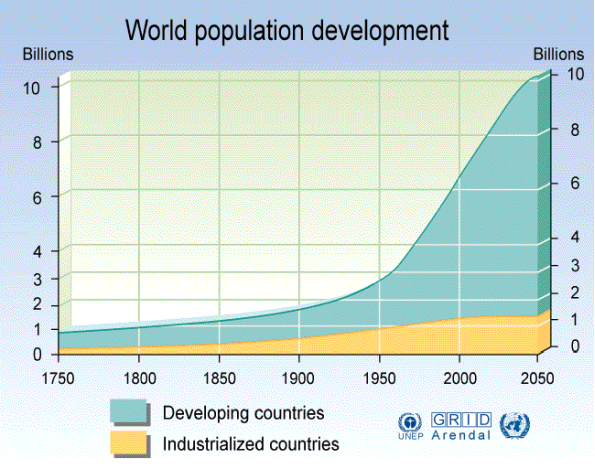Every sperm is sacred? (Re)productive struggles in the quest for sustainability
Due to a number of factors, the issue of population growth has become removed from the discussion on sustainability. I explore some of the ethical presumptions that underlie the issues linking population growth and sustainability.
After the pre-publication of an article on the oversight and even denial of population growth, Haydn Washington and I received a surprising number of reactions, notably from anthropologists. A brief summary of the article and reactions is presented below.
Population growth: a good thing and a bad thing
Population growth has been propelled by a number of factors, including developments in antibiotic medicine, relative peace since the Second World War, and more efficient food production. Today, although diseases such as zika, ebola, malaria, and HIV have not yet been entirely eliminated, the chances of surviving these diseases have greatly increased. The deadly pandemics of diseases such as cholera, plague, and tuberculosis, which decimated entire populations, seem to be a thing of the past. While diseases of the wealthy world, such as cancer and diabetes, may be on the rise, they no longer condemn patients to death. Better health, peace, and abundant food are certainly something we welcome.

Philippe Rekacewicz, UNEP/GRID-Arendal
Yet the negative side of population growth has also been noted. One of the best known and most criticized classical texts on population control is the Essay on the Principle of Population (1798), by the (in)famous pessimist Thomas Malthus. Malthus postulated that there were certain ‘checks’ on population expansion, that arose ‘from the difficulty of subsistence’; these included war, diseases, and starvation. He argued that as land and resources were not unlimited, population growth must be limited to avoid these checks. The publication of Ehrlich’s The Population Bomb in 1968 linked some Malthusian ideas to twentieth-century issues surrounding sustainability.
Gregory Bateson noted how when faced with challenges of altered natural conditions, we tend to focus on modifying our environment rather than ourselves. Bateson argued that these fundamental causes of environmental crisis lie in the combined action of (a) technological advances, (b) population increase, and (c) conventional (but wrong) ideas about the ‘nature of man’ and his relation to the environment. The very first requirement for ecological stability is a balance between the rates of birth and death. While human ingenuity expressed through Industrial Revolution in manufacturing and Green revolution in agriculture helped us to produce enough goods and food to prove Malthus and Ehrlich wrong in their dire predictions, the question still remains to what point can the planet sustain our population.
Yet it seems that linking population growth and sustainability has become controversial. In recent decades population growth has become a divisive issue in the discourse on sustainability, with debates ranging from ambiguity to open hostility toward ‘blaming’ overpopulation. Critics such as Fletcher et al. argue that we do not have a global over-population issue, but a global issue of over-population of just the highly privileged and exploitative minority, and that population growth is used as scapegoat by rich over-consuming elites.
The idea that the poor’s footprint is insignificant and we should only focus on overconsuming elites is a common opinion held by many authors who publish on online platforms such as Just Conservation or Survival International, as well as journals such as Conservation and Society. In this critique, those who link population to sustainability (in particular, conservationists and generalized ‘environmentalists’) are branded neo-Malthusian, racist, or misanthropic. The ethical issue advanced is that the global ‘North’ or ‘West’ should not tell people in the ‘South’ that they should have fewer children; this opens a Pandora’s box of accusations.
Since the UN Cairo Conference on Population in 1994 stopped talking about ‘family planning’ as a priority, funding for family planning has dropped worldwide. More recently, policy documents issued in 2015 in the context of the United Nations’ Sustainable Development Goals (SDGs) do not seriously address population issues. The agenda for the SDGs includes concerns about the necessity to provide food for a growing population. There is little discussion about stabilizing and then reducing population, nor any discussion of ethical questions about the intrinsic value of nature in an age in which numerous species have become extinct.
So why is population growth not adequately addressed?
Many economists have noted that a larger population is good for expanding markets (see population-related issues of the Economist). Basically, the sum goes as follows: the more people, the more consumers; the larger the labor force, the more young people to pay old people’s pensions. For this reason, in many countries high fertility is actually stimulated.
Other supposedly more noble and ‘enlightened’ reasons for not addressing population include the ‘sanctity’ of human life. This concept is perhaps most memorably expressed in the song by the British comedy group Monty Python: ‘Every sperm is sacred’:
In a surprising alliance, colonial powers (including Christian missions that discouraged the use of contraception), development policy-makers, and most anthropologists have rejected traditional means of birth control such as abortion and infanticide. Most anthropologists, generally tolerant toward cultural relativity, have also rejected human sacrifice and tribal warfare. Not many anthropologists, except for Bateson and Smail, have openly raised the issue of overpopulation.
The question of other populations
Concern for human life stands in stark contrast to the relative disregard for nonhuman populations used in industrial food-production systems, and for the huge areas of previously wild habitats cleared for agricultural and urban development. Today, there is a growing disproportion between the number of people on earth and the number of nonhuman animals left in the wild. While the apex predators are normally checked by environmental constraints, this is no longer the case for our own species.
In the case of non-human populations, their proximity to humans either in urban or agricultural areas is often experienced as a problem. While the urban ‘pests’ are feared to carry diseases, those animals and insects that ‘trespass’ on agricultural land are blamed for destroying harvests.
Alcott argues that we should not just ask after the maximum number of humans who can sustainably subsist. Rather, we should imagine a desirable life above subsistence level, bearing in mind that the loss of wilderness and natural beauty is impoverishing if viewed anthropocentrically, and immoral if non-human life forms have rights.
To return to Bateson, ‘the bigger the population, the faster it grows; the more technology we have, the faster the rate of new invention; and the more we believe in our "power" over an enemy environment, the more "power" we seem to have and the more spiteful the environment seems to be.’ The sheer scale of human influence on the environment today is unprecedented in evolutionary history. From a biological point of view, having seven billion apex predators, either the ‘innocent’ poor or the ‘guilty’ rich, implies increased demand of food, be it factory produced, hunted, or scavenged.

Calvin & Hobbes, by Bill Watterson
The question of poverty
One of the persistent claims is that resource use by marginal communities, those of the ‘victimized South’, is ‘relatively benign’. However, factors such as the growing middle class in developing countries and migration from low- to high-consumption areas are rarely taken into consideration. Also, little attention is paid to the fact that the rich and poor have different kinds of environmental impacts, as Crist and Cafaro summarize:
‘To scrutinize the global North and see only the variable of consumption is to remain blind to that mass that qualifies it. A major factor underlying destructive consumerism is population size: the sheer numbers of consumers around the globe. To propagate the myth that population growth is not itself a problem and to lament, instead, the harmful effects of unsustainable production and consumption bypasses one leading reason that production and consumption are unsustainable.’
The destructive reach of the affluent is global, whereas that of the poor tends to be more localized, involving deforestation and the acceleration of the bushmeat trade, leading to the ‘empty forest syndrome’.
Dividing people into the bad (rich, Western) consumers and the innocent (poor, non-western) bottom class makes any objection to population growth morally charged. Kenneth Smail reflects that despite the impossibility of decoupling population from sustainability concerns, the issue of population growth has gained a certain ‘political charge’.
All agree that all humans deserve to have equal opportunities for health, well-being, happiness, and basic necessities. Yet denying the problem of the growing population—whose material appetites and life expectancy have greatly increased—is detrimental to any long-term objective of achieving sustainability, as the twin forces of industrial and demographic expansion will cause greater pressure on the planet and thus hurt future generations, as Wijkman and Rockström have shown. Leaving population growth out of sustainability challenges, including achieving circular economy, degrowth or steady economy tends to exacerbate challenges of economic transition. Thus, support of alternative economies based on degrowth in rich countries and the promotion of non-coercive measures to address population growth globally are both needed.

Last but not least, a position that population is ‘not a problem’ actually threatens to ignore the needs of the poor themselves. Memory Banda, a Malawian girl who told her story on TED talk clearly indicates the extent of the problem of the victims of unwanted pregnancies:
By some estimates, there are about 215 million women who want access to contraception but are denied it and thus suffer unwanted pregnancies.
Also, often a high birth rate correlates with poverty. Following from this, it is assumed that as soon as economic welfare rises, birth rates will drop, as is evident in most countries in Europe and Japan. Yet empirical evidence shows that in the many parts of the world the number of women of child-bearing age is disproportionately large, this ‘population momentum’ being likely to outrun fertility decline.
Denying that population growth in developing world is one of the drivers of unsustainability can only be true if one expects that the poor will never escape poverty, nor ever migrate to the more economically developed countries. This is obviously not the ideal of equality and freedom that social justice advocates, myself included, would embrace.

Summing up: solutions
It is important to emphasize that population control should never be coercive. There are many humane strategies the world can adopt to reduce the growing impact that our numbers are creating. Population Media is one of the platforms educating people about such strategies. Robert Engelman provides some examples of how to stabilize population:
1. Ensure access to contraceptives and family planning.
2. Guarantee education through secondary school for all (especially girls).
3. Eradicate gender bias from laws, economic opportunity, health, and culture.
4. Offer age-appropriate sexuality education for all.
5. End all policies that financially reward parents for having more children.
6. Integrate teaching about population, environment, and development into all school curricula.
7. Put full pricing on environment costs and impacts.
8. Adjust to population ageing, rather than trying to delay it through government programs aimed at boosting birth rates.
9. Convince leaders to commit to ending population growth through the exercise of human rights and human development.
In implementing these steps, we need to consider culturally sensitive issues. In some contexts, children are seen as investment, especially when families are poor. In other contexts, being rich entails having more children as a status symbol. Some groups might actually prefer to have a large number of children, regardless of their socio-economic status. In these cases, more culturally sensitive approaches might work better.
A hopeful direction is enlisting help of the reproductive health community and social justice community, as well as women’s rights advocates. It is not ‘anti-human’ to discuss overpopulation. On the contrary, it shows the deepest concern for future generations and the life they will lead.
References
Alcott, B. 2015. Population matters. In: Kopnina H. and Shoreman-Ouimet E., eds. Sustainability: Key issues. Routledge Earthscan, New York.
Bateson, G. 1972. The Roots of Ecological Crises. In Bateson, G. From Steps to an Ecology of the Mind. Chicago: University of Chicago Press. pp. 494-499.
Cafaro P. and Crist, E. 2012. Life on the brink: environmentalists confront overpopulation. Georgia, US: University of Georgia Press, pp. 283-300.
The Economist. 2012. America’s demographic squeeze: Double bind. Available from: http://www.economist.com/news/united-states/21568398-falling-birth-rate-and-much-slower-immigration-presage-long-term-trouble-ahead-double.
The Economist. 2012. Demography: Virility symbols. August 11, pp. 34.
The Economist. 2012. Free Exchange: Baby monitor. August 11. pp. 59.
Ehrlich, P. R. 1968. The population bomb. New York: Ballantine Books.
Engelman R. 2012. Nine population strategies to stop short of 9 billion. In: Starke L, ed. State of the world 2012: moving toward sustainable prosperity. Washington: Island Press.
Fletcher, R., Breitlin, J., Puleo, V. 2014. Barbarian hordes: the overpopulation scapegoat in international development discourse. Third World Quarterly. 35(7):1195– 1215.
Kopnina, H. and Washington, H. 2016. Discussing why population growth is still ignored or denied. Chinese Journal of Population, Resources and Environment. http://dx.doi.org/10.1080/10042857.2016.1149296.
Smail, K. 2003. Remembering Malthus III: Implementing a Global Population Reduction. American Journal of Physical Anthropology, 123 (2):295-300.
Wijkman, A. and Rockström, J. 2012. Bankrupting nature: denying our planetary boundaries. New York: Routledge.



4 Comments
Ref. Helena on october 3, 2016 at 22.08
To this day1 most National Governments are natalistic or fallistic and reluctant to limit the size of their population, or even worse they strive for its growth. In both cases a certain amount of (indirect) legal coercion is always involved, e.g. prohibition of human abortus or a ban on buying / selling of contraceptives. This in addition to public moral pressure.
Under this conditions we should not be afraid or being ethically hampered to accept governmental measures, this time to stop population-explosions. China took this step and we may be grateful for it. China acted really modern and set an example worth following worldwide imitation.
So I would advocate that you insert2 into your list of ‘SOLUTIONS’: direct governmental coercion. Compulsion this time to fight an population augmentation the consequences of which are so utterly foreseeable: poverty, individual physical suffering (woman), wars, dying outs, modern mass migrations, genocides3. And that so needlessly and lovelessly. Only in Buddhisme we find a formal awareness of the misery of birth. By the way: I love beautiful babies.
1) Some ‘Primitive Societies’ were more advanced than modern ones on mastering the size of their population (e.g. Torrestraiters).
2) If you dare of course, for even these times it remains a hot issue. I understand fully if you don’t.
3) About genocides and demographics, see: PRUNIER, G., - THE RUANDA CRISIS | Columbia UP Press, N. York, 1995.
Dear HPax, China has scrapped off its one child policy which was indeed coercive. The greatest effort can be channelled into human- and women's right related issues. UNICEF and human rights organizations note that in some countries like Bangladesh or Ghana the majority of women marries (or is forced to marry) before the age of 18 and has a number of children before the age of 21. One cannot say that the women necessarily choose to have these children. Also, see in my article: “By some estimates, there are about 215 million women who want access to contraception but are denied it and thus suffer unwanted pregnancies”.
In your ‘Summing up: solutions’, you stipulate that ‘It is important to emphasize that population control should never be coercive.’
Well then, what do you think of the enforcement of birth control of the Chinese Government upon the Chinese people?
Thank you in advance for your coming answer,
HPax
In your ‘Summing up: solutions’, you stipulate that ‘It is important to emphasize that population control should never be coercive.’
Well then, what do you think of the enforcement of birth control of the Chinese Government upon the Chinese people?
Thank you in advance for your coming answer,
HPax
Add a comment